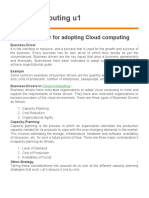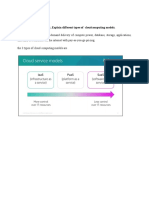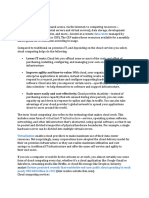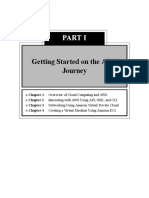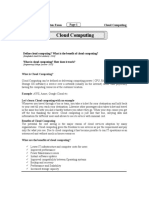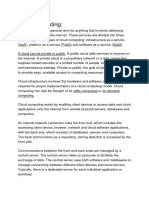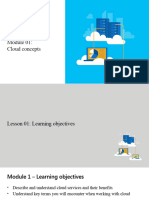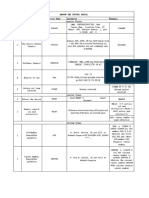1.What is Cloud Computing? Explain different types of cloud computing service modelsCloud computing
is the on-demand delivery of compute power, database, storage, applications, and other IT resources via the internet with pay-as-you-go pricing. These resources run on server computers that arelocated in large data centers in different locations around the world. When you use a cloud service provider like AWS, that service provider owns the computers that you are using. These resources can be used together like building blocks to build solutions that help meet business goals and satisfy technology requirements.There are three main cloud service models. Each model represents a different part of the cloud computingstack and gives you a different level of control over your IT resources:
•
Infrastructure as a service (IaaS)
: Services in this category are the basic building blocks for cloud IT and typically provide you with access to networking features, computers (virtual or on dedicated hardware), and data storage space. IaaS provides you with the highest level of flexibility and management control over your IT resources. It is the most similar to existing IT resources that many IT departments and developers are familiar with today.
•
Platform as a service (PaaS)
: Services in this category reduce the need for you to manage the underlying infrastructure (usually hardware and operating systems) and enable you to focus on the deployment and management of your applications.
•
Software as a service (SaaS)
: Services in this category provide you with a completed product that the service provider runs and manages. In most cases,
software as a service
refers to end-user applications. With a SaaS offering, you do not have to think about how the service is maintained or how the underlying infrastructure is managed. You need to think only about how you plan to use that particular piece of software. A common example of a SaaS application is web-based email, where you can send and receive email without managing feature additions to the email product or maintaining the servers and operating systems that the email program runs on.
2. Define Cloud Computing and Advantages of cloud Computing in detail. Cloud computing
is the on-demand delivery of compute power, database, storage, applications, and other IT resources via the internet with pay-as-you-go pricing. These resources run on server computers that arelocated in large data centers in different locations around the world. When you use a cloud service provider like AWS, that service provider owns the computers that you are using. These resources can be used together like building blocks to build solutions that help meet business goals and satisfy technology requirements.
Advantage #1—Trade capital expense for variable expense
:
Capital expenses (capex)
are funds that a company uses to acquire, upgrade, and maintain physical assets such as property, industrial buildings, or equipment. Do you remember the data center example in the traditional computing model where you needed to rack and stack the hardware, and then manage it all? You must pay for everything in the data center whether you use it or not.By contrast, a
variable expense
is an expense that the person who bears the cost can easily alter or avoid. Instead of investing heavily in data centers and servers before you know how you will use them, you can pay only when you consume resources and pay only for the amount you consume. Thus, you save money on technology. It also enables you to adapt to new applications with as much space as you need in minutes, instead of weeks or days. Maintenance is reduced, so you can spend focus more on the core goals of your business.
Advantage #2—Benefit from massive economies of scale
: By using cloud computing, you can achieve a lower variable cost than you can get on your own. Because usage from hundreds of thousands of customers is aggregated in the cloud, providers such as AWS can achieve higher economies of scale, which translates into lower pay-as-you-go prices.
Advantage #3—Stop guessing capacity
: Eliminate guessing about your infrastructure capacity needs. When you make a capacity decision before you deploy an application, you often either have expensive idle resources or deal with limited capacity. With cloud computing, these problems go away. You can access as much or as little as you need, and scale up and down as required with only a few minutes’ notice.
Advantage #4—Increase speed and agility
: In a cloud computing environment, new IT resources are only a click away, which means that you reduce the time it takes to make those resources available to your developers from weeks to just minutes. The result is a dramatic increase in agility for the organization because the cost and time that it takes to experiment and develop are significantly lower.
Advantage #5—Stop spending money on running and maintaining data centers
: Focus on projects that differentiate your business instead of focusing on the infrastructure. Cloud computing enables you to focus on your own customers instead of the heavy lifting of racking, stacking, and powering servers.
Advantage #6—Go global in minutes
: You can deploy your application in multiple AWS Regions around the world with just a few clicks. As a result, you can provide a lower latency and better experiencefor your customers simply and at minimal cost
3. What is AWS? Explain six core perspectives which need to be considered while moving to AWS cloud.
Amazon Web Services (AWS) is a secure cloud platform that offers a broad set of global cloud-based products. Because these products are delivered over the internet, you have on-demand access to the compute, storage, network, database, and other IT resources that you might need for your projects—and the tools to manage them. You can immediately provision and launch AWS resources. The resources are ready for you to use in minutes. AWS offers flexibility. Your AWS environment can be reconfigured and updated on demand, scaled up or down automatically to meet usage patterns and optimize spending, or shut down temporarily or permanently. The billing for AWS services becomes an operational expense instead of a capital expense.AWS services are designed to work together to support virtually any type of application or workload. Think of these services like building blocks, which you can assemble quickly to build sophisticated, scalable solutions, and then adjust them as your needs change.The AWS Cloud Adoption Framework (AWS CAF) provides guidance and best practices to help organizations identify gaps in skills and processes. It also helps organizations build a comprehensive approach to cloud computing—both across the organization and throughout the IT lifecycle—to accelerate successful cloud adoption. At the highest level, the AWS CAF organizes guidance into six areas of focus, called
perspectives
. Perspectives span people, processes, and technology. Each perspective consists of a set of
capabilities
, which covers distinct responsibilities that are owned or managed by functionally related stakeholders.
Capabilities within each perspective are used to identify which areas of an organization require attention. By identifying gaps, prescriptive work streams can be created that support a successful cloud journey.
Six core perspectives
In general, the Business, People, and Governance perspectives focus on business capabilities, while the Platform, Security, and Operations perspectives focus on technical capabilities.
Business perspective
: Stakeholders from the Business perspective (for example, business managers, finance managers, budget owners, and strategy stakeholders) can use the AWS CAF to create a strong business case for cloud adoption and prioritize cloud adoption initiatives. Stakeholders should ensure that an organization’s business strategies and goals align with its IT strategies and goals.
People perspective:
Stakeholders from the People perspective (for example, human resources, staffing, and people managers) can use the AWS CAF to evaluate organizational structures and roles, new skill and process requirements, and identify gaps. Performing an analysis of needs and gaps can help prioritize training, staffing, and organizational changes to build an agile organization.
Governance perspective
: Stakeholders from the Governance perspective (for example, the Chief Information Officer or CIO, program managers, enterprise architects, business analysts, and portfolio managers) can use the AWS CAF to focus on the skills and processes that are needed to align IT strategy and goals with business strategy and goals. This focus helps the organization maximize the business valueof its IT investment and minimize the business risks.
Platform perspective :
Stakeholders from the Platform perspective (for example, Chief Technology Officer or CTO, IT managers, and solutions architects) use a variety of architectural dimensions and models to understand and communicate the nature of IT systems and their relationships. They must be able to describe the architecture of the target state environment in detail. The AWS CAF includes principles and patterns for implementing new solutions on the cloud, and for migrating on-premises workloads to the cloud.
Security perspective:
Stakeholders from the Security perspective (for example, Chief Information Security Officer or CISO, IT security managers, and IT security analysts) must ensure that the organization meets security objectives for visibility, auditability, control, and agility. Security perspectivestakeholders can use the AWS CAF to structure the selection and implementation of security controls thatmeet the organization’s needs.
Operations perspective:
Stakeholders from the Operations perspective (for example, IT operations managers and IT support managers) define how day-to-day, quarter-to-quarter, and year-to-year business is conducted. Stakeholders from the Operations perspective align with and support the operations of the business. The AWS CAF helps these stakeholders define current operating procedures. It also helps them identify the process changes and training that are needed to implement successful cloud adoption.
4. Define web services and Explain any 6 Categories of AWS services
A web service is any piece of software that makes itself available over the internet and uses a standardized format—such as Extensible Markup Language (XML) or JavaScript Object Notation (JSON)—for the request and the response of an application programming interface (API) interaction.
5. Define Total Cost Ownership (TCO). Explain 4 TCO considerations used in AWS
Total Cost of Ownership (TCO) is the financial estimate to help identify direct and indirect costs of a system.
Why use TCO?
To compare the costs of running an entire infrastructure environment or specific workload on-premises versus on AWSTo budget and build the business case for moving to the cloudSome of the costs that are associated with data center management include: Server costs for both hardware and software, and facilities costs to house the equipment. Storage costs for the hardware, administration, and facilities. Network costs for hardware, administration, and facilities. And IT labor costs that are required to administer the entire solution. When you compare an on-premises to cloud solution, it is important to accurately assess the true costs of both options. With the cloud, most costs are upfront and readily calculated. For example, cloud providers give transparent pricing based on different usage metrics, such as RAM, storage, and bandwidth, among others. Pricing is frequently fixed per unit of time. Customers gain certainty over pricing and are then able to readily calculate costs based on several different usage estimates. Compare this process to on-premises technology. Though they are sometimes difficult to determine, calculations of in-house costs must take into account all:Direct costs that accompany running a server—like power, floor space, storage, and IT operations to manage those resources.Indirect costs of running a server, like network and storage infrastructure.








